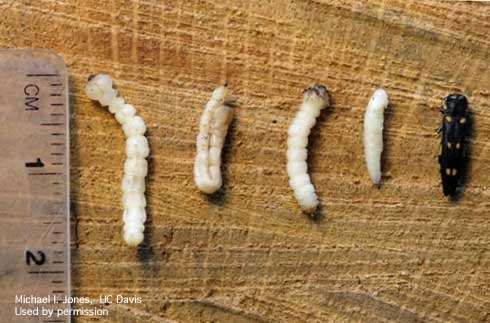UC IPM released a new Pest Note in January 2013 on the goldspotted oak borer. This Pest Note has the first official UC guidelines for managing the pest.

The most seriously damaged oaks are those in the red oak group including coast live oak, Quercus agrifolia, and black oak, Q. kelloggi. It also infests canyon live oak, Q. chrysolepis but has not been found to kill the other native oak species in the area, the Englemann oak, Q. englemanni. So far losses have been most serious in parks and forested areas, but landscape trees are also being killed.
A new Pest Note from the UC IPM program outlines management guidelines for this serious pest. Flatheaded borers such as GSOB are difficult to manage and seriously infested trees cannot be saved. The primary way GSOB spreads into new areas is through the movement of infested wood and the authors recommend leaving infested wood on site for 2 years. If wood is to be moved, the Pest Note provides guidelines for treating it through containment, grinding, and debarking. Guidelines for replanting infested areas, less susceptible oak species, biological control, insecticide applications and developing GSOB management plans are also described.
Many other borers attack oaks but do not kill trees. GSOB infested trees can be distinguished by the characteristic D-shaped emergence holes it leaves behind. A special feature of the Pest Note is a table illustrating the emergence holes of borer species on southern California oaks. Many photos are also included.
The information in this Pest Note: Goldspotted Oak Borer is based primarily on research studies by the authors: Mary Louise Flint (UCIPM and Entomology/UC Davis), Tom Coleman and Steve Seybold (USDA/US Forest Service), and Mike Jones (Entomology/UC Davis). Find it at http://www.ipm.ucdavis.edu/PMG/PESTNOTES/pn74163.html